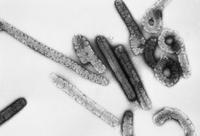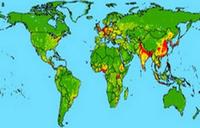-
New biosurveillance Web site offers comprehensive information on outbreaks, responses
A new online resource is providing a centralized portal for all news, information, resources, and research related to biosurveillance at the laboratory. Los Alamos Lab science team gathers a virtual biological toolkit for international disease outbreak response.
-
-
Ebola epidemic ebbing: WHO
The World Health Organization(WHO) has reported fewer than 100 new cases of Ebola in West Africa in the last week, which means the outbreak could soon reach its end. Some of the resources allocated to building treatment centers for thousands of sick people are now being diverted to contact-tracing efforts. “Efforts have moved from rapidly building infrastructure to ensuring that capacity for case finding, case management, safe burials and community engagement is used as effectively as possible,” read the WHO’s latest situation report.
-
-
Ebola outbreak: where we are now and what happens next
Ever since its discovery, it has been appreciated that Ebola poses a serious risk to global public health. Infectious diseases represent a global threat, not just to those within the country or region of emergence. With the current increase in the movement of people (rural to urban, within countries and across borders), this risk will inevitably increase. While the current priority should be to contain the present outbreak, there is a great need to plan for prevention of future events. The development of an international response group tasked with immediate assessment of and initial response to emerging pathogens is needed, backed by sufficient international political will, clinical expertise, and funding. This needs to be agile and responsive, with clear chains of command, and able to engage early.
-
-
Speeding up Ebola drug production
Researchers at the University of California, Davis, will explore ways to speed production of the Ebola drug Zmapp with a $200,000 rapid-response grant from the National Science Foundation. Zmapp is a cocktail of antibodies produced in and extracted from whole tobacco plants. The UC Davis team, including plant scientists, molecular biologists and chemical engineers, will attempt to produce the antibodies from plant cells grown in bioreactors instead of in whole plants.
-
-
High security Australian laboratory advancing Ebola research
With the Ebola epidemic still a threat, many in the international disease research community are searching for a cure. One such laboratory is a high-security facility in Geelong, Australia. It focuses exclusively on Ebola research and testing, particularly the Zaire strain of the virus, which has ravaged Guinea, Liberia, and Sierra Leone.
-
-
IMF-imposed reforms undermined healthcare provision in Ebola-stricken West Africa
Researchers criticize reforms advocated by the International Monetary Fund (IMF) for chronically under-funded and insufficiently staffed health systems in Guinea, Liberia, and Sierra Leone. They say these policies contributed to “lack of preparedness” of West African health systems to cope with disease and emergencies such as Ebola. The researchers argue that IMF programs over the years have imposed heavy constraints on the development of effective health systems of Guinea, Liberia, and Sierra Leone — the cradle of the Ebola outbreak that has killed more than 6,800 since March this year.
-
-
2014: A trying year for U.S. health agencies
2014 has been a trying year for U.S. health officials. Globalization and the movement of people from previously remote villages to large cities introduced diseases such as Ebola to places where the flu virus was once considered the most alarming public health scare. “If anyone still needed convincing, 2014 really showed that a disease threat anywhere is a disease threat everywhere,” said Dr. Tom Frieden, CDC director. A series of mishaps in handling deadly pathogens in CDC and NIH labs raised questions about the safety culture in U.S. biolabs.
-
-
Progress made in slowing Ebola spread in West Africa – but it is still spreading
Nearly 20,000 people have been infected with the Ebola virus since December 2013, and about 7,700 of them have died. Over 90 percent of patients live in West Africa, where poor public healthcare systems have accelerated the spread of the disease. As 2015 approaches, healthcare officials in West Africa are seeing progress in eradication efforts. Ebola-infected dead bodies are being picked up from the streets of major towns and properly buried by government workers, and more patients are being admitted to hospitals due to an increase in the number of hospital beds available. Yet, despite the progress made in recent weeks, Ebola is still spreading in remote villages. “It is encouraging to see that when we get to a place where Ebola is spreading quickly, we can end that cluster within a month or two,” said one expert. “But the problem is, there are clusters all over, and new ones popping up all the time,” adding: “This is going to be a long, hard fight.”
-
-
Klain defends CDC protocols after lab technician’s potential exposure to Ebola
The Obama administration’s Ebola czar, Ron Klain, yesterday (Sunday) defended the security procedures of the Centers for Disease Control and Prevention (CDC), after a technician at one of the agency’s labs in Atlanta was potentially exposed to the deadly disease. The CDC has been criticized earlier this year not only for its response to the Ebola outbreak and Ebola cases within the United States. Numerous safety violations and lax procedures have been reported in the CDC’s labs and in the manner the agency’s technicians transport lethal pathogens, including anthrax and botulism bacteria, from one lab to another.
-
-
Improved protective suit for Ebola caregivers
An advanced protective suit for health care workers who treat Ebola patients, devised by a Johns Hopkins University team, is one of the first five awardees in a federal funding contest aimed at quickly devising new tools to combat the deadly disease. The JHU prototype is designed to do a better job than current garments in keeping health care workers from coming in contact with Ebola patients’ contagious body fluids, both during treatment and while removing a soiled suit. In addition, it is expected to keep the wearer cooler — an important benefit in hot, humid regions such as West Africa.
-
-
Preventing animal-borne diseases from affecting humans

Roughly 75 percent of newly emerging diseases are zoonotic, which means that they can spread from animals to humans. Incredibly damaging, these diseases usually wreak havoc on humans, who rarely have natural defenses to protect them against such strains. About 2.7 million people die each year from zoonotic diseases. It is estimated that between 1997 and 2009, the cost of dealing with and treating these types of diseases around the world amounted roughly $80 billion. Scientists hope that by connecting human medical and veterinary science, and by organizing and establishing different medical professionals along a spectrum of disease detection, it would be possible to thwart the outbreak of another zoonotic disease.
-
-
The growing economic cost of infectious diseases
Emerging pandemic disease outbreaks such as Ebola increasingly threaten global public health and world economies, scientists say. We can expect five new such diseases each year, into the future. We should also expect them to spread. The tropical disease dengue fever, for example, has made its way to Florida and Texas, seemingly to stay. Five new such diseases expected each year; strategies to reduce climate change adaptable to infectious diseases. Economists, disease ecologists, and others collaborated on an in-depth economic analysis of strategies to address pandemic threats in a proactive way — rather than a reactive response to a crisis.
-
-
Texas Ebola task force calls for revamping state’s preparations for epidemics
The Texas Task Force on Infectious Disease Preparedness and Responsehas called for the establishment of two specialized Ebola treatment centers in Texas, and for new methods to monitor vulnerable health care workers, especially those returning from West Africa.The state acknowledges that it alone is unable to handle an infectious disease outbreak like Ebola. The task force wants federal health and disease authorities to provide actionable information during disease outbreaks.
-
-
World can be separated into seven regions for vectored human diseases

Researchers have for the first time mapped human disease-causing pathogens, dividing the world into a number of regions where similar diseases occur. The findings show that the world can be separated into seven regions for vectored human diseases — diseases which are spread by pests, like mosquito-borne malaria — and five regions for non-vectored diseases, like cholera.
-
-
World's response to Ebola slow, inconsistent, inadequate: Médecins sans Frontières
The NGO Médecins sans Frontières (MSF) has harshly criticized the international community for its slow and inconsistent response to the Ebola crisis in West Africa. MSF says the world’s response risks creating “a double failure” because ill-equipped locals in Sierra Leone, Liberia, and Guinea have been left to run hospitals and treatment centers. MSF international president, Dr. Joanne Liu, said it was “extremely disappointing that states with biological-disaster response capacities have chosen not to deploy them.”
-
- All
- Regional
- Water
- Biometrics
- Borders/Immig
- Business
- Cybersecurity
- Detection
- Disasters
- Government
- Infrastructure
- International
- Public health
- Public Safety
- Communication interoperabillity
- Emergency services
- Emergency medical services
- Fire
- First response
- IEDs
- Law Enforcement
- Law Enforcement Technology
- Military technology
- Nonlethal weapons
- Nuclear weapons
- Personal protection equipment
- Police
- Notification /alert systems
- Situational awareness
- Weapons systems
- Sci-Tech
- Sector Reports
- Surveillance
- Transportation
Advertising & Marketing: advertise@newswirepubs.com
Editorial: editor@newswirepubs.com
General: info@newswirepubs.com
2010-2011 © News Wire Publications, LLC News Wire Publications, LLC
220 Old Country Road | Suite 200 | Mineola | New York | 11501
Permissions and Policies
Editorial: editor@newswirepubs.com
General: info@newswirepubs.com
2010-2011 © News Wire Publications, LLC News Wire Publications, LLC
220 Old Country Road | Suite 200 | Mineola | New York | 11501
Permissions and Policies
